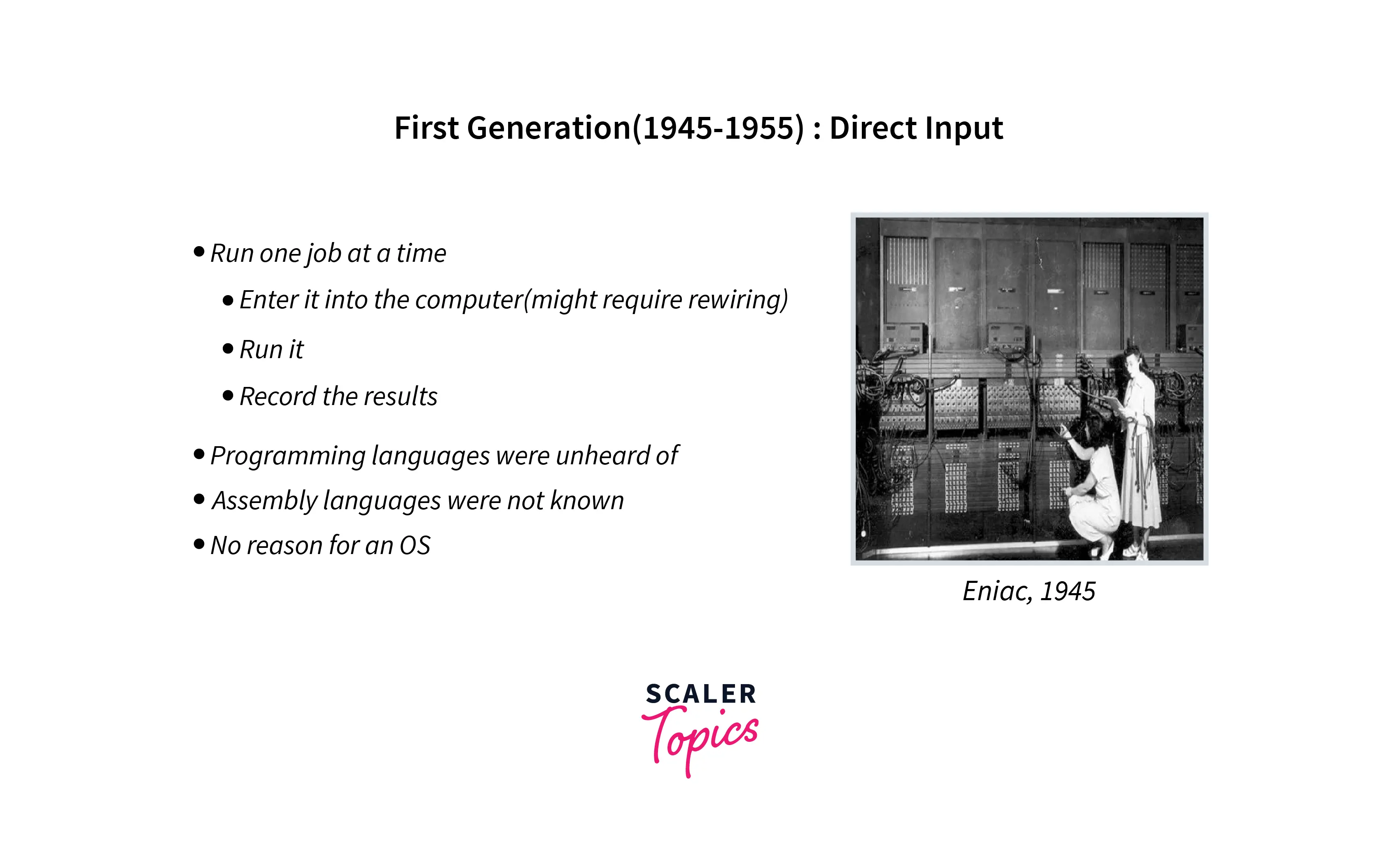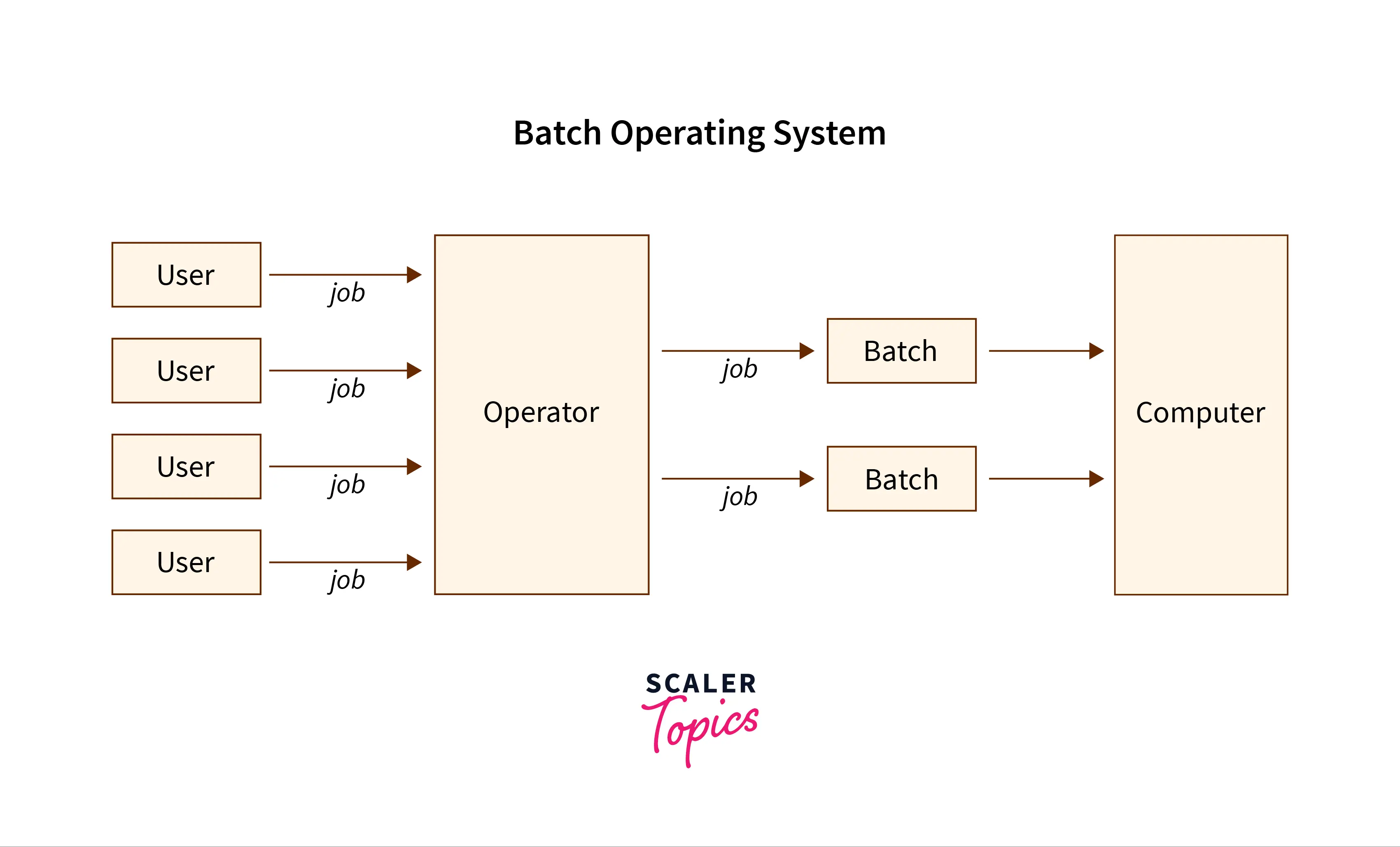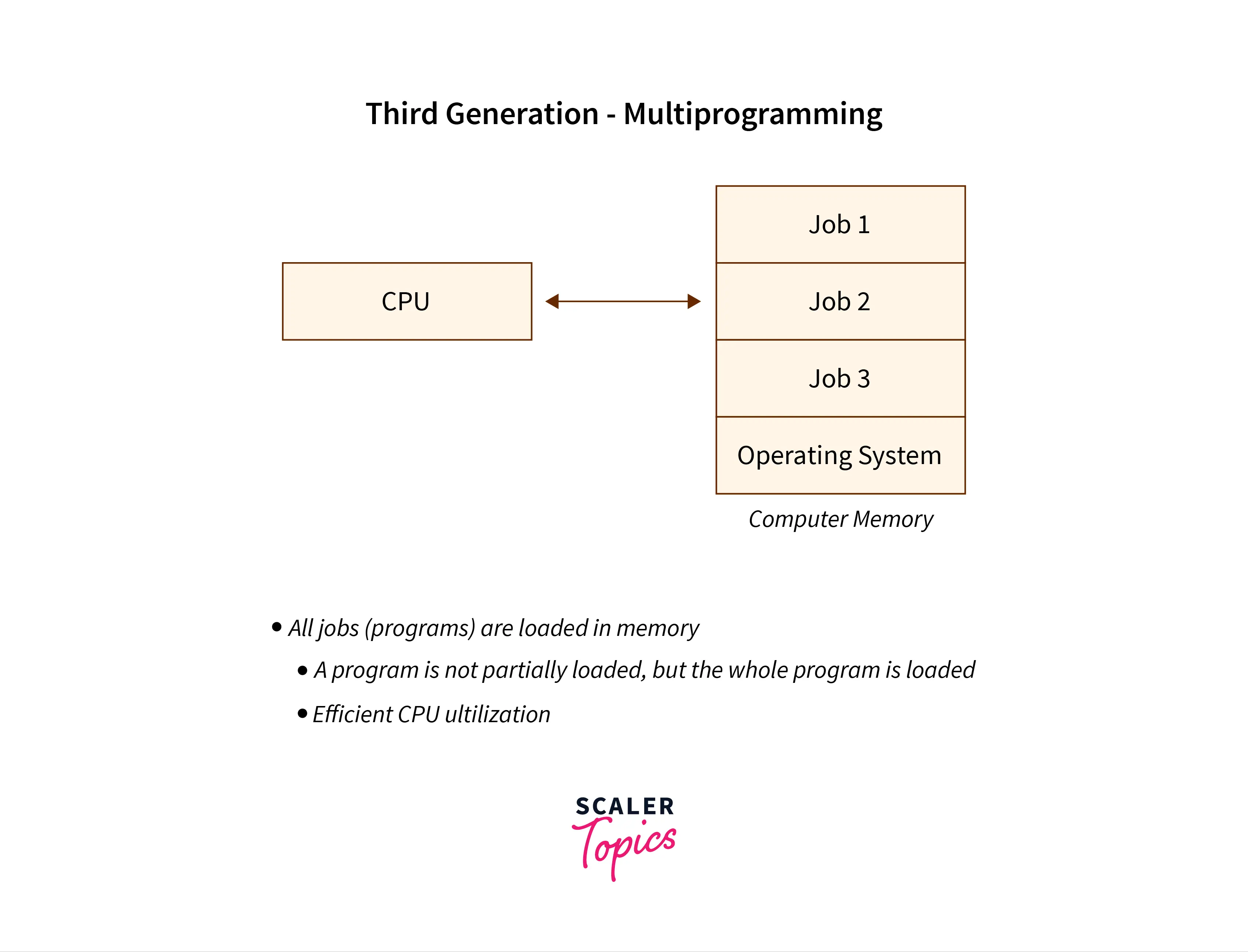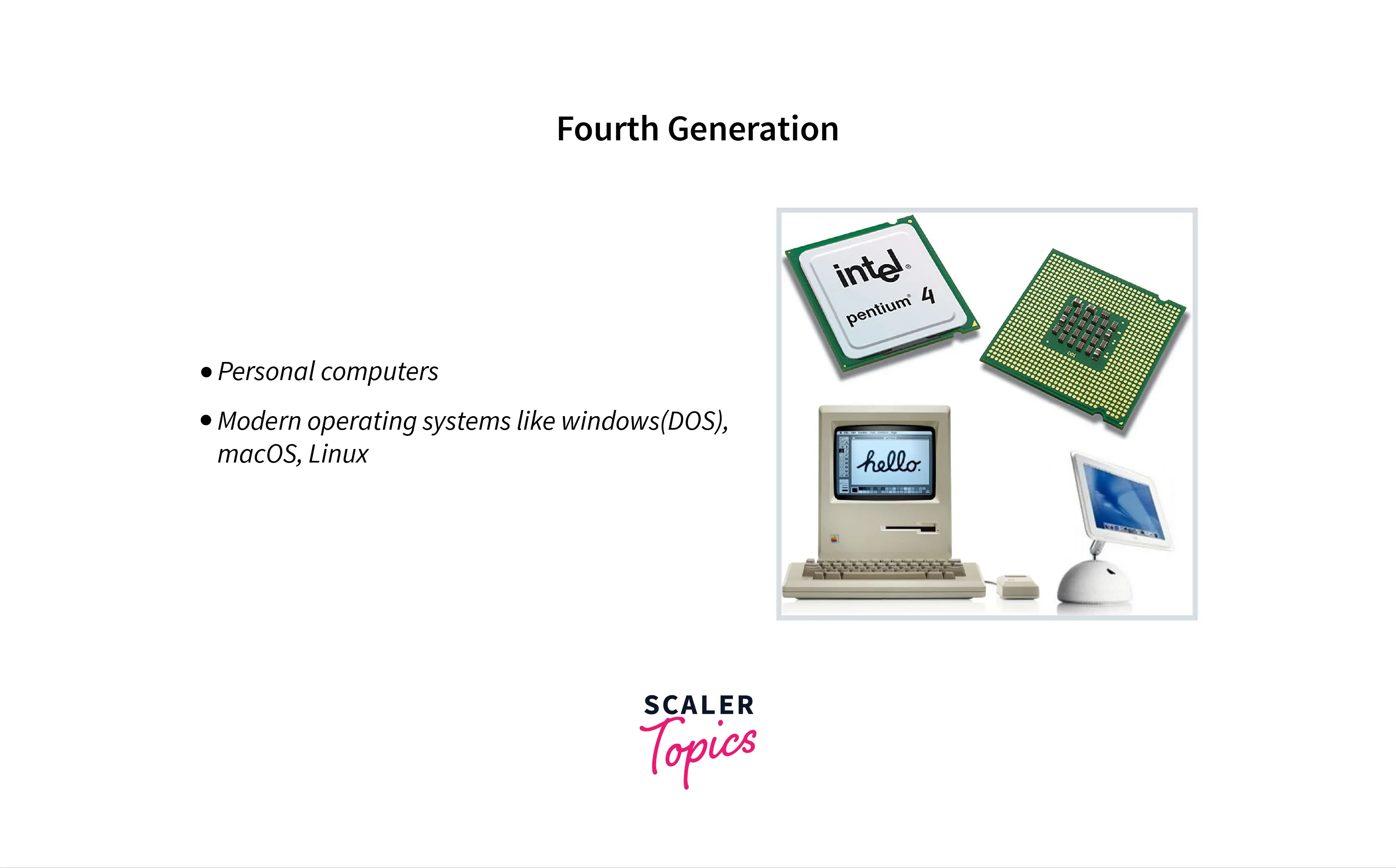Evolution of Operating System
An Operating System is nothing but a software program that acts as an interface between the hardware, the application software, and users.
The main aim of an operating system is to manage all the computer resources, security, file systems, etc. So, we can simply say that the operating system gives a platform to the application software and other system software to perform their task.
To delve deeper into the intricacies of operating systems, you can explore comprehensive resources available at Scaler's Operating System Tutorial.
Evolution of Operating System - OS Generations
Operating System is not the same as we see today. Let us discuss the evolution of operating system in detail. In today's world, we can see that a user of the computer directly interacts with the computer. But in the past years, the users were not able to directly interact with the computer system.
From a broader perspective, the evolution of operating system can be divided into four generations. Let us briefly discuss this generation-based evolution of operating system with their timeline.
1. No Generation(0s to 1940s)
In the earliest days of computing, there were no distinct operating systems as we know them today. Computers were operated manually, often requiring extensive knowledge of the machine's hardware. Programs were directly fed into the computer, typically through the use of punch cards or other rudimentary input methods.
2. First Generation (1945-1955)
The first generation of the operating system was used in the year to during the time of electronic computing systems development. It was the era of mechanical computing systems where the users or the programmers used to provide the instructions (through punch cards, paper tape, and magnetic tape, etc.) and the computer had to follow them. Now, due to the human intervention, the process was very slow and there were chances of human mistakes.
We can say that there is no operating system at that time and users used to give the programs to the computer system itself. So, less speed and more errors were the first-generation operating systems' drawbacks.

3. Second Generation (1955-1965)
The second generation of the operating system was used from the year to during the time of batch operating system development. During the second generation phase, the users used to prepare their instructions (tasks or jobs) in the form of jobs on an off-line device like punch cards and submits them to the computer operator. Now, out of these punch cards (these punch cards were tabulated into instructions for computers), similar punch cards of jobs were grouped and run as a group to speed up the entire process. The jobs consisted of program and input data along with the control instructions. The main task of the programmer or developer was to create jobs or programs and then hand them over to the operator in the form of punch cards. Now, it was the duty of an operator to sort the programs with similar requirements into batches.
Some major drawbacks of the second generation operating system were:
- We could not set the priority of the jobs as jobs were scheduled only basis of similarities among the jobs.
- The CPU was not utilized to its max potential as the CPU becomes idle (when the operator was loading jobs).

4. Third Generation (1965-1980)
The third generation of the operating system was used in the year to during the time of multiprogramming operating system development. The third generation operating system was developed to serve more than one user at a time (multi-users). During this period, users were able to communicate with the operating systems with the help of a software called command line interface. So, the computers became multi-user and multiprogramming.

5. Fourth Generation (1980-Now)
The fourth generation of the operating system is being in from the year till now. Before the evolution of the fourth generation of the operating system, the users were able to communicate with the operating system but with the help of command line interfaces, punch cards, magnetic tapes, etc. So, the user had to provide commands (that needed to be remembered) which became hectic.
So, the fourth generation of operating systems came into existence with the development of GUI (Graphical User Interface). The GUI made the user experience more convenient.
This 4th generation can be subdivided into further three categories:
-
Networked Systems (1980s to 1990s): This era witnessed the proliferation of networked computing environments, enabling multiple computers to communicate and share resources over a network.
-
Mobile Operating Systems (Late 1990s to Early 2000s): The late 20th century and early 21st century saw the emergence of mobile operating systems, specifically designed for handheld devices. This development fundamentally changed how we interacted with technology.
-
AI Integration (2010s to ongoing): In recent years, operating systems have integrated Artificial Intelligence (AI) technologies. This has led to more intelligent and adaptive computing experiences.
We can also terminate the fourth generation operating system era the era of the distributed operating systems. Now, the operating systems can be found in a mobile devices, smartwatches, fitness bands, smart glasses, VR gears, and so on. We are now surrounded by various versions of the operating system.

FAQ
Q. What is the significance of the first generation of operating systems?
A: The first generation of operating systems marked the early stages of electronic computing systems. Users interacted with computers through punch cards and other manual input methods. However, this era was characterized by slow processes and a higher risk of human errors.
Q. How did the second generation improve upon the first?
A. The second generation introduced batch processing, where users prepared instructions as jobs on offline devices like punch cards. These jobs were then submitted to a computer operator, and similar jobs were grouped together for more efficient processing. However, there were limitations in job prioritization and CPU utilization.
Q. What was the key development in the third generation of operating systems?
A. The third generation introduced multiprogramming operating systems, allowing multiple users to interact with the system simultaneously. The introduction of command-line interfaces facilitated user interaction with the operating system.
Q. How did the fourth generation revolutionize user experience?
A. The fourth generation brought about the development of Graphical User Interfaces (GUIs), which significantly improved the user experience. Prior to this, users interacted with the operating system through command-line interfaces, punch cards, and other methods. The GUI made interactions more intuitive and user-friendly.
Q. What are some notable sub-eras within the fourth generation of operating systems?
A. The fourth generation encompasses various sub-eras, including the era of Networked Systems (1980s to 1990s), which saw the proliferation of networked computing environments. This was followed by the rise of Mobile Operating Systems (Late 1990s to Early 2000s), specifically designed for handheld devices. In recent years, there has been a focus on AI Integration (2010s to ongoing), leading to more intelligent and adaptive computing experiences.
Conclusion
- The evolution of operating systems is a testament to the rapid advancement of computing technology over the decades.
- Each generation brought significant improvements, from manual operations to batch processing, and eventually to the introduction of Graphical User Interfaces (GUIs) in the fourth generation.
- This GUI revolutionized user interaction, making computing more accessible and user-friendly for people around the world.
- Additionally, the fourth generation witnessed the expansion of operating systems into various devices, from mobiles to wearables, becoming an integral part of our daily lives.
- The integration of Artificial Intelligence (AI) in recent years has further elevated the capabilities of operating systems, promising even more intelligent and adaptive computing experiences in the future.
The evolution of operating systems is a testament to human ingenuity, paving the way for a future where computing seamlessly integrates with our daily lives in ways we could have only imagined.
